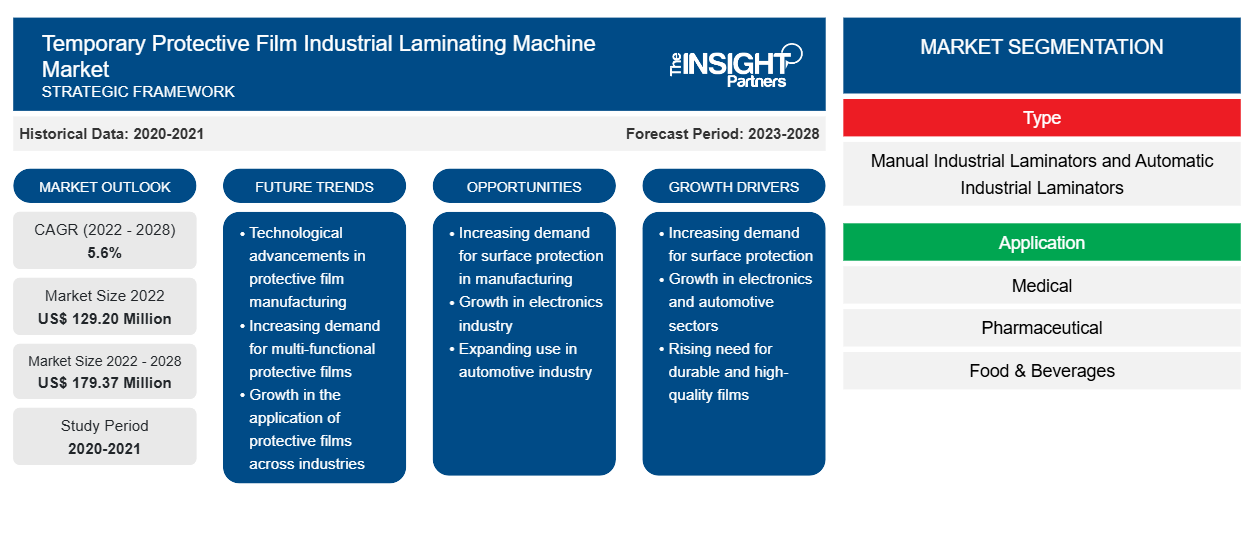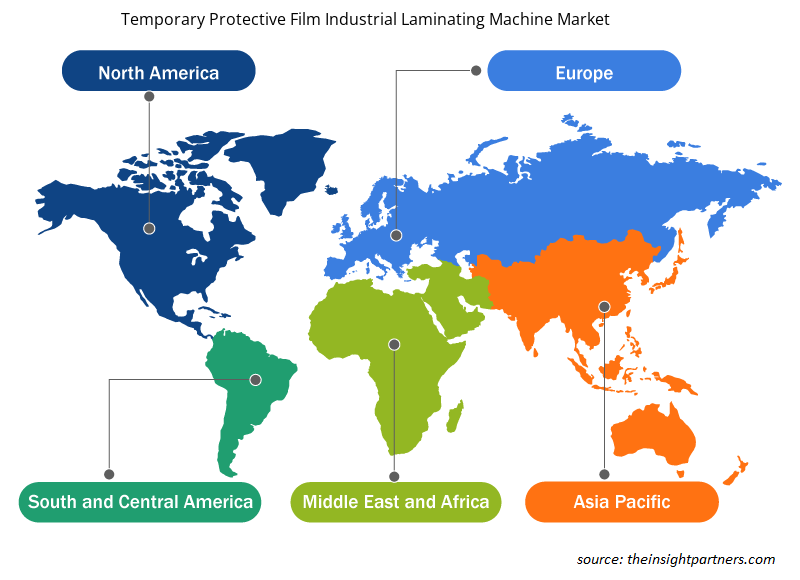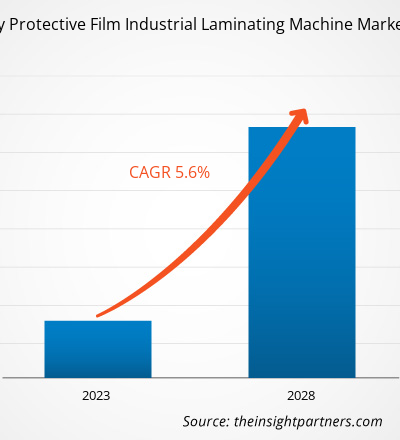Si prevede che il mercato delle macchine per laminazione industriale con pellicola protettiva temporanea crescerà da 129,20 milioni di dollari nel 2022 a 179,37 milioni di dollari entro il 2028; si stima che il mercato registrerà un CAGR del 5,6% dal 2022 al 2028.
La crescente adozione di fabbriche intelligenti e Industrial 4.0 è un fattore chiave che contribuisce alla domanda di macchine per laminazione industriale di pellicole protettive temporanee in Francia. Ad esempio, le industrie manifatturiere francesi hanno speso circa 26,52 miliardi di dollari (25 miliardi di euro) in ricerca e sviluppo ogni anno dal 2016 per sviluppare tecnologie moderne. Inoltre, l'aerospaziale è l'industria più importante nel settore manifatturiero francese, seguita rispettivamente dall'industria automobilistica e farmaceutica. La Francia è il secondo esportatore mondiale di attrezzature aeronautiche, mentre è al primo posto in Europa in termini di produzione di aerei ed elicotteri civili e militari. Nel 2020, in Francia c'erano 4.480 aziende nel settore aerospaziale. Il governo francese sta investendo sempre di più nel settore aerospaziale per il suo ulteriore sviluppo. Ad esempio, a giugno 2020, il governo ha annunciato un investimento di 17 miliardi di dollari per sostenere questo settore. A settembre 2022, il governo ha annunciato che l'industria aerospaziale avrebbe assistito a un investimento di oltre 9,55 miliardi di dollari (9 miliardi di euro) nei tre anni successivi. Pertanto, il progresso dell'industria manifatturiera aerospaziale stimola l'adozione di macchine per laminazione industriale di pellicole protettive temporanee in Francia.
Mercato delle macchine per laminazione industriale di pellicole protettive temporanee -
Personalizza questo report in base alle tue esigenze
Riceverai la personalizzazione gratuita di qualsiasi report, comprese parti di questo report, o analisi a livello nazionale, pacchetto dati Excel, oltre a usufruire di grandi offerte e sconti per start-up e università
Mercato delle macchine per laminazione industriale con pellicola protettiva temporanea: approfondimenti strategici

-
Scopri le principali tendenze di mercato in questo rapporto.Questo campione GRATUITO includerà analisi di dati che spaziano dalle tendenze di mercato alle stime e alle previsioni.
Impatto della pandemia di COVID-19 sulla crescita del mercato delle macchine per laminazione industriale di pellicole protettive temporanee dell'Asia-Pacifico
La pandemia di COVID-19 ha colpito drasticamente due enormi mercati nell'APAC: India e Cina. I lockdown e il rallentamento industriale in questi paesi hanno interrotto la catena di fornitura di varie materie prime e beni. La pandemia ha ostacolato notevolmente le dinamiche aziendali durante la prima metà del 2020. La chiusura temporanea delle industrie manifatturiere e l'interruzione delle catene di fornitura sono state tra le principali implicazioni della pandemia. Tuttavia, nel 2021, le attività manifatturiere sono riprese con l'allentamento delle misure di lockdown. La crescente domanda di dispositivi elettronici di consumo nell'APAC ha comportato la necessità di macchine per laminazione industriale con pellicola protettiva temporanea. Inoltre, i crescenti investimenti e l'aumento delle vendite di dispositivi elettronici di consumo nel periodo post-pandemia stanno alimentando la crescita del mercato delle macchine per laminazione industriale con pellicola protettiva temporanea nell'APAC.
Approfondimenti di mercato – Mercato delle macchine per laminazione industriale di pellicole protettive temporanee
In base alla geografia, il mercato delle macchine per laminazione industriale con pellicola protettiva temporanea è principalmente segmentato in Nord America, Europa, Asia Pacifico (APAC), Medio Oriente e Africa (MEA) e Sud America (SAM). Si prevede che l'Europa rappresenti la quota di mercato maggiore nel 2022 e che mantenga il suo predominio durante il periodo di previsione. Inoltre, si prevede che l'Asia Pacifico registrerà il CAGR più elevato nel mercato delle macchine per laminazione industriale con pellicola protettiva temporanea durante il periodo di previsione.
Si prevede che l'Asia Pacifica deterrà la seconda quota di mercato più grande del mercato delle macchine per laminazione industriale di pellicole protettive temporanee nel 2022. I settori aerospaziale e medico sono i principali contributori alla domanda di macchine per laminazione industriale di pellicole protettive temporanee in questa regione. La crescente adozione dell'automazione e l'emergere dell'Industria 4.0 stanno accelerando l'utilizzo di varie macchine in applicazioni industriali e di fabbrica, offrendo opportunità redditizie per gli operatori del mercato delle macchine per laminazione industriale di pellicole protettive temporanee che operano in questa regione.
L'industria automobilistica trae vantaggio dalle iniziative governative favorevoli nei paesi dell'Asia Pacifica. Secondo l'Organizzazione internazionale dei costruttori di veicoli a motore, nel 2020 la Cina ha prodotto il numero più alto di veicoli al mondo, tra cui 310.000 veicoli commerciali e 1,77 milioni di autovetture. Secondo l'India Brand Equity Foundation, la produzione annuale di automobili in India nel 2021 è stata di 22,65 milioni e ha prodotto 13 milioni di veicoli da aprile 2021 a ottobre 2021. Inoltre, il governo indiano prevede di attrarre investimenti locali ed esteri di 8-10 miliardi di dollari nell'industria automobilistica entro il 2023. Tali prospettive di crescita nell'industria automobilistica guiderebbero l'uso di macchine di laminazione industriale con pellicola protettiva temporanea nelle operazioni di imballaggio per proteggere le superfici interne ed esterne dei veicoli da graffi e abrasioni, il che stimolerà ulteriormente la crescita del mercato delle macchine di laminazione industriale con pellicola protettiva temporanea.benefitted from favorable government initiatives in Asia Pacific countries. According to the International Organization of Motor Vehicle Manufacturers, in 2020, China produced the highest number of vehicles in the world, including 310,000 commercial vehicles and 1.77 million passenger cars. According to the India Brand Equity Foundation, the annual production of automobiles in India in 2021 was 22.65 million, and it produced 13 million vehicles from April 2021 to October 2021. Furthermore, the Government of India expects to attract local and foreign investments of US$ 8–10 billion in the automobile industry by 2023. Such growth prospects in the automotive industry would drive the use of temporary protective film industrial laminating machines in packaging operations to protect the interior and exterior surfaces of vehicles from scratches and abrasions which will further boost the growth of temporary protective film industrial laminating machine market.
A novembre 2021, Bostik ha rafforzato la sua attività di laminazione nell'area Asia-Pacifico firmando un accordo di acquisto con Nordmeccanica, un fornitore di macchine laminatrici industriali di ultima generazione. L'azienda ha posizionato questa nuova attrezzatura nel suo centro di ricerca e sviluppo di Shanghai con l'obiettivo di servire alimenti e bevande, beni di consumo in rapida evoluzione, prodotti farmaceutici e applicazioni industriali nell'area Asia-Pacifico.Bostik strengthened its lamination business in Asia Pacific by signing purchase agreement with Nordmeccanica, a latest generation industrial laminator machine supplier. The company placed this new equipment in its Shanghai R&D center with an aim to serve food & beverage, fast-moving consumer goods, pharmaceuticals, and industrial applications in Asia Pacific.
Approfondimenti regionali sul mercato delle macchine per laminazione industriale con pellicola protettiva temporanea
Le tendenze regionali e i fattori che influenzano il mercato delle macchine per laminazione industriale con pellicola protettiva temporanea durante il periodo di previsione sono stati ampiamente spiegati dagli analisti di Insight Partners. Questa sezione discute anche i segmenti e la geografia del mercato delle macchine per laminazione industriale con pellicola protettiva temporanea in Nord America, Europa, Asia Pacifico, Medio Oriente e Africa e America meridionale e centrale.

- Ottieni i dati specifici regionali per il mercato delle macchine per laminazione industriale di pellicole protettive temporanee
Ambito del rapporto di mercato delle macchine per laminazione industriale con pellicola protettiva temporanea
| Attributo del report | Dettagli |
|---|---|
| Dimensioni del mercato nel 2022 | 129,20 milioni di dollari USA |
| Dimensioni del mercato entro il 2028 | 179,37 milioni di dollari USA |
| CAGR globale (2022 - 2028) | 5,6% |
| Dati storici | 2020-2021 |
| Periodo di previsione | 2023-2028 |
| Segmenti coperti |
Per tipo
|
| Regioni e Paesi coperti |
America del Nord
|
| Leader di mercato e profili aziendali chiave |
|
Densità dei player del mercato delle macchine per laminazione industriale con pellicola protettiva temporanea: comprendere il suo impatto sulle dinamiche aziendali
Il mercato delle macchine per laminazione industriale di pellicole protettive temporanee sta crescendo rapidamente, spinto dalla crescente domanda degli utenti finali dovuta a fattori quali l'evoluzione delle preferenze dei consumatori, i progressi tecnologici e una maggiore consapevolezza dei vantaggi del prodotto. Con l'aumento della domanda, le aziende stanno ampliando le loro offerte, innovando per soddisfare le esigenze dei consumatori e capitalizzando sulle tendenze emergenti, il che alimenta ulteriormente la crescita del mercato.
La densità degli operatori di mercato si riferisce alla distribuzione di aziende o società che operano in un particolare mercato o settore. Indica quanti concorrenti (operatori di mercato) sono presenti in un dato spazio di mercato in relazione alle sue dimensioni o al valore di mercato totale.
Le principali aziende che operano nel mercato delle macchine per laminazione industriale di pellicole protettive temporanee sono:
- HMT Produzione Inc.
- Hsing Wei Machine Industry Co Ltd
- APL Macchinari Pvt Ltd
- Armatura di superficie LLC
- Walco Inc
Disclaimer : le aziende elencate sopra non sono classificate secondo un ordine particolare.

- Ottieni la panoramica dei principali attori del mercato delle macchine per laminazione industriale con pellicola protettiva temporanea
Approfondimenti basati sulle applicazioni – Mercato delle macchine per laminazione industriale di pellicole protettive temporanee
In base all'applicazione, il mercato delle macchine per laminazione industriale con pellicola protettiva temporanea è suddiviso in settori medico, farmaceutico, alimentare e delle bevande, automobilistico, aerospaziale e della difesa e altri. Il segmento automobilistico ha rappresentato la quota maggiore del mercato nel 2021. Il segmento automobilistico utilizza ampiamente la soluzione di lavorazione con laminazione temporanea per proteggere il componente dai graffi durante il processo di produzione. Inoltre, nell'inventario, le pellicole temporanee sono ampiamente utilizzate per proteggere gli esterni delle auto.
Gli operatori del mercato delle macchine per laminazione industriale di pellicole protettive temporanee si concentrano principalmente sullo sviluppo di sistemi avanzati ed efficienti.
- Nel 2022, ASHTON INDUSTRIAL ha acquisito il 100% delle attività e delle attività di UNIVERSAL LAMINATORS Ltd., Oxfordshire.
- Nel 2019, Charter NEX Films ha annunciato la sua collaborazione con HP Indigo per lanciare nuovi film sigillanti Pack Ready Lamination PE, convalidati da Karlville per l'uso con il laminatore HP Indigo Pack Ready. Pertanto, il laminatore fornisce imballaggi flessibili di alta qualità con una soluzione di laminazione facile e sicura per gli alimenti.
- Analisi storica (2 anni), anno base, previsione (7 anni) con CAGR
- Analisi PEST e SWOT
- Valore/volume delle dimensioni del mercato - Globale, Regionale, Nazionale
- Industria e panorama competitivo
- Set di dati Excel
Report recenti
Testimonianze
Motivo dell'acquisto
- Processo decisionale informato
- Comprensione delle dinamiche di mercato
- Analisi competitiva
- Analisi dei clienti
- Previsioni di mercato
- Mitigazione del rischio
- Pianificazione strategica
- Giustificazione degli investimenti
- Identificazione dei mercati emergenti
- Miglioramento delle strategie di marketing
- Aumento dell'efficienza operativa
- Allineamento alle tendenze normative






















 Ottieni un campione gratuito per - Mercato delle macchine per laminazione industriale di pellicole protettive temporanee
Ottieni un campione gratuito per - Mercato delle macchine per laminazione industriale di pellicole protettive temporanee